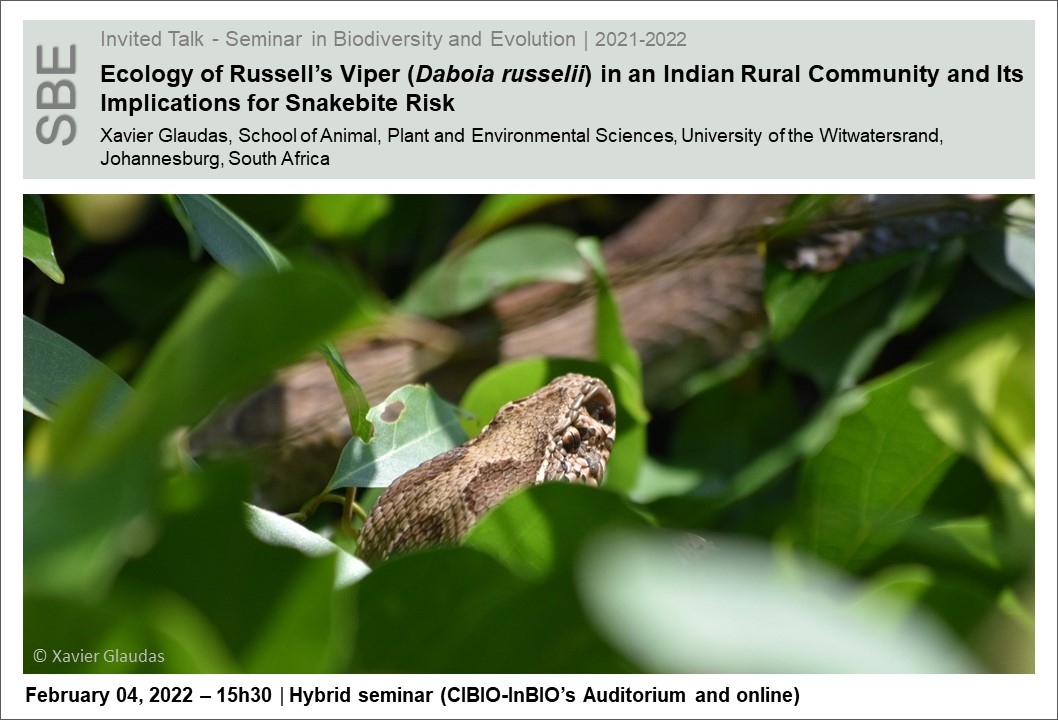Ecology of Russell’s Viper (Daboia russelii) in an Indian Rural Community and Its Implications for Snakebite Risk
04 Feb 2022 - Xavier Glaudas, School of Animal, Plant and Environmental Sciences, University of the Witwatersrand, Johannesburg, South Africa | 15h30

INVITED TALK - SEMINAR IN BIODIVERSITY AND EVOLUTION
Apart from disease vectors, venomous snakes are responsible for more human mortality and morbidity than any other group of animals, particularly in the rural tropics where they are a public health concern. Measures to improve health care practices and the production and distribution of effective and affordable antivenoms have been identified to decrease the snakebite toll. However, the dearth of information on the medically important snakes themselves has hindered our understanding of the ecology of this human-animal conflict.
I conducted a nine-month radio-telemetry project to study the spatial and behavioral ecology of a population of Russell’s vipers (Daboia russelii), one of the most medically important snakes in the world, in a rural community in India, the country experiencing the most snakebite deaths worldwide. I took advantage of this study to also estimate how frequently inhabitants of this Indian rural community were observed in the vicinity of radio-equipped vipers and to examine patterns of human proximity to the snakes.
Snakes were the least active in March, an extremely dry and hot month, and spatial activity comparatively increased from November-January and in May. People were more frequently observed near vipers in January and July compared to March, but all other month contrasts were statistically similar. These patterns indicates that snakebite incidence, which peaks in summer in the study area, is not particularly linked to snake activity and encounter frequency between people and vipers. Further, vipers spent a substantial amount of time in plantations and, consistent with snakebite epidemiological data, agricultural workers were more likely to be observed near snakes compared to the rest of the population.
Altogether, by collecting detailed snake ecological data and integrating the spatio-temporal locations of people and snakes in relation to one another, this study provides a model approach to help better understand the human-venomous snake conflict worldwide.
Xavier Glaudas is a French organismal biologist whose primary research interests lie in behavioral and evolutionary ecology. For the last 20 years, Xavier has travelled the world to study vipers, one of his favorite group of animals. He conducted his graduate studies in the USA and his postdoc in South Africa, and his research essentially addresses ‘pure’ or ‘fundamental’ questions in snake ecology with a focus on space use, predator-prey relationships and mating systems. Recently, Xavier has applied his knowledge of viper ecology—and the methods to study them—to conduct research with applicable guidelines to human health. As such, he spent a year as a research consultant with an Indian NGO to develop a radio-telemetry project on Russell’s viper (Daboia russelii), one of the most medically important snakes in the world. Xavier is the author of ca. 30 scientific articles, including some published in high-impact journals, and the recipient of two research grants from the National Geographic Society in the last eight years.
[Host: Fernando Martínez-Freiría, Biodiversity of Deserts and Arid Regions - BIODESERTS, Phenotypic Evolution - PHENEVOL]
Online access to the seminar: https://fc-up-pt.zoom.us/j/85001936844